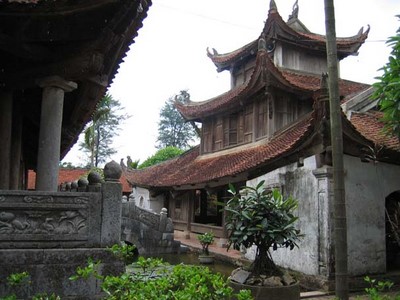Duong River: Preserving A Rich History and Culture

Duong River is rich in culture and history. In fact, a poem was written in its honour, simple yet precise and effective that it has enticed many people from all over the world to visit the place.
Duong River runs through Bac Ninh Province and located at Thuan Thanh District. It is a typical provincial setting with white sand banks, mulberry groves, banana fields, maize, sweet potato, green vegetables and other plantations all around. The houses are usually small but identified with their red-tiled roofs. Chickens and other farm animals freely roam around while children blissfully play with nature.
But if there is something that makes the community stand out from everywhere else, it is its unique cultural and historical make up, specifically represented by two important sites: the Dong Ho folk painting village and the But That Temple.
Dong Ho folk painting village is one of the few villages in the whole region that has been able to preserve the ancient cultural relics of the Kinh Bac area in the Red River Delta of Northern Vietnam. The art has existed for centuries and has been carefully protected by three families: Nguyen Dang Che, Nguyen Huu Sam and Tran Nhat Tan. Through time, artists have turned to votive papers to keep up with the modern times. But lately, they have returned to the traditional form perhaps in realization that the latter is an undeniable part of their culture and life in general and they have to embrace it. This is usually pronounced during Tet wherein their paintings are sold. But recently too, because of the renewed interest in the traditional art, these masterpieces are no longer sold only during the Lunar New Year and in six fairs in December, but throughout the year.
Dong Ho paintings are famous for several reasons: they reflect joy and humanitarian values; they are colourful; and they are made from natural materials. One favourite work is that of a wood block printed on paper from the bark of the do (poonah) tree which depicts peace, happiness and prosperity. Another usual style is a provincial setting found in the area such as farm animals and natural landscapes. The Catching Coconuts and Mice Wedding are two masterpieces which have earned not only domestic but international attention.
But That Pagoda is a popular tourist destination because of its excellent architecture and rich history. The place is so breathtaking that it has been featured in many movies. The temple is said to have originated as early as the 13th century where several significant structures can be found. The wooden statue of Avalokitesvara with its thousand eyes and thousand arms is the largest in Vietnam and considered a true work of art. The Bao Nghiem is a five-storey, 13 metre-high stone bell tower shaped like a gigantic pen symbolic of the local people’s love of learning. In fact, Bac Ninh Province may be small but it produced top scholars during the feudal regime. Other 17th century woodcarving statues and objects can be found in the pagoda. But That Pagoda was recognized as a national treasure in 2012.
Moreover, Duong River is fairly accessible. It can be reached either by bus or motorbike from Ha Noi and is about a 30-kilometre ride which is comfortable and totally worth it.









